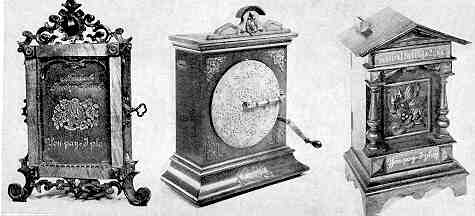The Three Musical Savings Banks
by F.H. Griffith - HOBBIES Magazine - May, 1966

Not one, but three different type Musical Savings Banks, are known to exist. All three operate on the same principle—the insertion of a coin starts a musical mechanism to play. Other than this and having the same name, the three banks are quite unalike, particularly appearance-wise. For classification purposes we have placed the banks in the following order—"Musical Savings Bank," "You pay—I play" easel or picture frame type, Figure 1, is No. 144; "The Musical Savings Bank" upright music box type, Figure 2, is No. 145; "Musical Savings Bank" "You pay—I play" house or building type, Figure 3, is No. 146.
Taking the banks in their numerical order we will first consider No. 144, Figure 1. L.C. Hegarty is the owner of this fine, completely original, Musical Savings Bank. It is made of wood, mainly walnut, with the frame front in a lighter color, like a light mahogany. As can be seen in the picture, ornate carved scrollwork is at the top and bottom of the frame along with a small amount on each side. The name, wording and center design work on the front wood panel are indented or stamped into the wood in gold. The locking key is shown inserted on the side of the bank and the entire back opens for removal of coins.
An original old catalog circa 1885 pictures and describes the Musical Savings Bank for sale. The catalog was issued by John F. Stratton & Company, Importers, 49 Maiden Lane, New York, and Lipsig, Saxony. The text of the ad for the bank is as follows:
Musical Savings Bank
Playing 2 Airs
#1876 each $7.50
A mantel-piece ornament, beautifully carved. On the front are the words "Musical Savings Bank" and the brief statement "You Pay—I Play."
There is in the top a hole large enough to admit small coins, and every time a piece of money is dropped in the box it plays one air.
This is entirely new this season, being made for us expressly from specifications of our own.
_________________
No. 145, Figure 2, is also in fine complete original condition and is owned by Leon Perelman. The name "The Musical Savings Bank" appears on the ornate brass plate on the front base as shown in the picture. This plate also tells the story as to the manufacturer as the name "Regina" and "Trade Mark" is inscribed thereon. This bank, like other Regina music boxes, is a well made item and the photo herewith well illustrates its good sturdy construction. Mr. Perelman has a Montgomery Ward Catalog #67, Summer of 1900, which pictures and describes the "Regina Musical Boxes." Text is as follows:
"The Regina is an automatic or self-playing musical instrument of American manufacture, and is not only far superior to the old style Swiss boxes, but everything considered, is the best music box made. Interchangeable metallic tune sheets or discs (one tune on each sheet) circular in shape, unlimited in number, are used instead of the old style cylinder.
The mechanism is driven by a strong spring motor, wound with detachable outside crank, and is so simple that it is not liable to get out of order. All working parts, like the tune sheet, are interchangeable, and in case any part is broken a new duplicate can be supplied quickly at a reasonable expense, and be replaced by any skilled mechanic.
The cases are either oak or mahogany, of attractive design and finely finished.
The tune sheets are made of steel, material and workmanship are the best and with proper care will last a lifetime."
This bank, by the way, is just about the largest in size of all the known mechanical banks being 17" high x 12" wide. For the record, some may say the Ferris Wheel occupies this position, but this is not the case as it isn’t an authentic mechanical bank. It is simply a toy that has been converted into a bank. As a matter of fact the conversion of the Columbian Ferris Wheel into a savings device is still being done to date, and it does seen a shame to ruin a fine original toy in this fashion.
__________________
No. 146, Figure 3, is a well made wood bank in walnut with interesting carving of a bird and nest with eggs (note photo). The bank pictured is in fine original condition and is in the collection of Mrs. Mary Gerken. The name "Musical Savings Bank" and wording "You pay—I play" are stamped in gold on two pieces of leather and fit into the provided sections on the bank as shown. The bank operates the same as the two previously described—a coin, dropped in the chimney slot in the roof in this case, starts the musical mechanism to play. Dates, manufacturer, and so on concerning this bank are unknown to the best of the writer’s knowledge. However, one pertinent piece of evidence is of importance. While the lettering of the names are not alike, please note Figure 1 and Figure 3 that the wording "You pay—I play" is identical. This is more than a coincidence and it is entirely possible that both banks were turned out by the same concern and in the same approximate time period.
